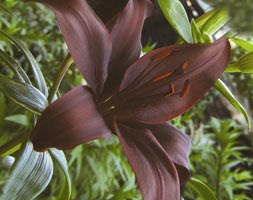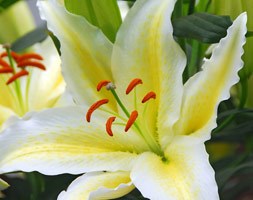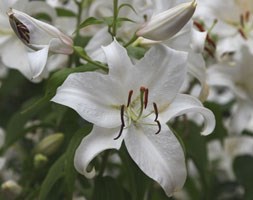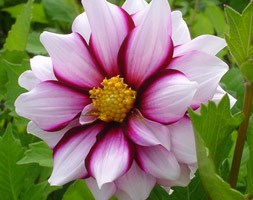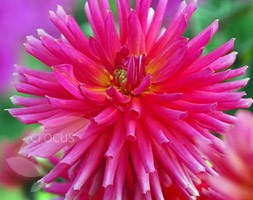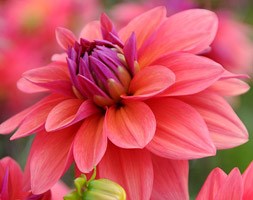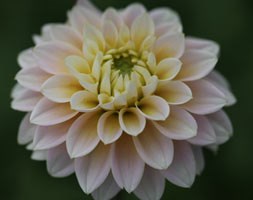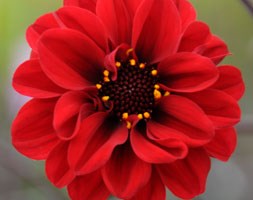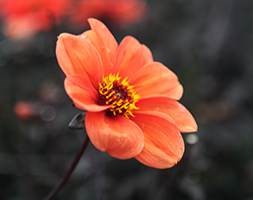Price reductions at Crocus
by Sarah - March 13th, 2014.Filed under: Crocus, Price Reductions.
Hundreds of price reductions at Crocus
Lilium ‘Dimension’ (lily) was £5.99 now £1.49
Position: partial shade Soil: moist, acidic soil Rate of growth: fast-growing Flowering period: July to August Flower colour: deepest red Hardiness: fully hardy Branching, near-black stems carry clusters of upward-facing, dark claret-coloured flowers from midsummer. An asiatic hybrid, the tepals that make up the trumpet-shaped flowers, become more re-curved as the flower ages. Garden care: Lilies can be planted at any time from early autumn, to mid-spring. Planting in autumn often helps them settle in and become better established before they start to put on their new spring growth, but spring planting is a better option if your soil is heavy and wet during winter. Choose a sunny spot, preferably where the plant receives a little light shade at its base, and plant each bulb 15-20cm (6-8in) deep in a well-drained soil, enriched with well-rotted organic matter or leaf mould. Space them at approximately 30cm (12″) intervals and provide support before the flowers appear. Deadhead the faded blooms promptly and cut the dead stems back to ground level at the end of autumn.
Lilium ‘Chill Out’ (Skyscraper lily) was £2.99 now £1.49
Position: full sun with light dappled shade at its base Soil: fertile, reliably moist soil Rate of growth: fast-growing Flowering period: July Flower colour: white and yellow Hardiness: fully hardy The huge flowers of this gorgeous, scented lily are mainly white, but each petal has a broad lemon yellow blotch in the centre. A florists favourite, these flowers last well after being cut and look very impressive in arrangements. Garden care: Lilies can be planted at any time from early autumn, to mid-spring. Planting in autumn often helps them settle in and become better established before they start to put on their new spring growth, but spring planting is a better option if your soil is heavy and wet during winter. Choose a sunny spot, preferably where the plant receives a little light shade at its base, and plant each bulb 15-20cm (6-8in) deep in a well-drained soil, enriched with well-rotted organic matter or leaf mould. Space them at approximately 30cm (12″) intervals and provide support before the flowers appear. Deadhead the faded blooms promptly and cut the dead stems back to ground level at the end of autumn.
Lilium ‘Casa Blanca’ (oriental lily bulb) was £2.99 now £1.49
Position: full sun Soil: well-drained soil enriched with leaf mould or a loam-based potting compost, such as John Innes no2 Rate of growth: average Flowering period: July to August Flower colour: pure white Other features: excellent cut-flowers Hardiness: fully hardy A classic oriental lily with sweetly fragrant, pure white flowers that delicately curve back towards the end of each petal and dark red stamens. The flowers are produced on tall stems from mid- to late summer and are ideal for the back of a sunny border. Universally loved for their big showy flowers, these lilies make excellent cut-flowers. Garden care: Lilies can be planted at any time from early autumn, to mid-spring. Planting in autumn often helps them settle in and become better established before they start to put on their new spring growth, but spring planting is a better option if your soil is heavy and wet during winter. Choose a sunny spot, preferably where the plant receives a little light shade at its base, and plant each bulb 15-20cm (6-8in) deep in a well-drained soil, enriched with well-rotted organic matter or leaf mould. Space them at approximately 30cm (12″) intervals and provide support before the flowers appear. Deadhead the faded blooms promptly and cut the dead stems back to ground level at the end of autumn.
Dahlia ‘Edge of Joy’ (dahlia tuber) was £3.49 now £1.74
Position: full sun Soil: fertile, humus-rich soil Rate of growth: average Flowering period: July to September Other features: excellent cut-flowers Hardiness: half hardy (may need winter protection) Single dahlias like this one are very popular with bees and other pollinating insects. This one is popular with people too as its pretty bi-coloured flowers appear for ages from midsummer and if you cut them for the vase (they last for ages) even more will come. Garden care: Dahlia tubers can be planted outside after frost, or started off in pots under glass in late winter to early spring. Plant them horizontally approximately 12cm deep, making sure the ‘eyes’ are uppermost. Allow enough room between each tuber so the plants can grow and spread to their full size without being over-crowded. While in growth, provide a high-nitrogen liquid feed each week in June, then a high-potash fertiliser each week from July to September. Stake with canes or brushwood if it becomes necessary. In mild areas, leave them in situ over winter, but protect the crown with a generous layer of dry mulch. In colder areas, carefully lift and clean the tubers once the first frosts have blackened the foliage and allow them to dry naturally indoors. Then place the dry tubers in a shallow tray, just covered with slightly moist potting compost, sand or vermiculite and store in a frost-free place until planting out again.
Dahlia ‘City of Leiden’ (dahlia tuber) was £3.49 now £1.74
Position: full sun Soil: fertile, humus-rich soil Rate of growth: average Flowering period: July to September Other features: excellent cut-flowers Hardiness: half hardy (may need winter protection) Apricot-pink, cactus flowerheads top dark stems, which rise above bronze-flushed foliage, putting on a great show from midsummer onwards. A reliable performer, it is relatively compact, so can also be grown in pots on the patio. Good for cutting too. Garden care: Dahlia tubers can be planted outside after frost, or started off in pots under glass in late winter to early spring. Plant them horizontally approximately 12cm deep, making sure the ‘eyes’ are uppermost. Allow enough room between each tuber so the plants can grow and spread to their full size without being over-crowded. While in growth, provide a high-nitrogen liquid feed each week in June, then a high-potash fertiliser each week from July to September. Stake with canes or brushwood if it becomes necessary. In mild areas, leave them in situ over winter, but protect the crown with a generous layer of dry mulch. In colder areas, carefully lift and clean the tubers once the first frosts have blackened the foliage and allow them to dry naturally indoors. Then place the dry tubers in a shallow tray, just covered with slightly moist potting compost, sand or vermiculite and store in a frost-free place until planting out again.
Dahlia ‘American Dawn’ (dahlia tuber) was £3.49 now £1.74
Position: full sun Soil: fertile, humus-rich soil Rate of growth: average Flowering period: July to September Other features: excellent cut-flowers Hardiness: half hardy (may need winter protection) A superb decorative dahlia with a blend of sumptuous shades. Initially, as the flowerhead opens, the predominant colour is rich pinkish purple, but as the ray-florets (petal) mature they turn a warm apricot. Garden care: Dahlia tubers can be planted outside after frost, or started off in pots under glass in late winter to early spring. Plant them horizontally approximately 12cm deep, making sure the ‘eyes’ are uppermost. Allow enough room between each tuber so the plants can grow and spread to their full size without being over-crowded. While in growth, provide a high-nitrogen liquid feed each week in June, then a high-potash fertiliser each week from July to September. Stake with canes or brushwood if it becomes necessary. In mild areas, leave them in situ over winter, but protect the crown with a generous layer of dry mulch. In colder areas, carefully lift and clean the tubers once the first frosts have blackened the foliage and allow them to dry naturally indoors. Then place the dry tubers in a shallow tray, just covered with slightly moist potting compost, sand or vermiculite and store in a frost-free place until planting out again.
Dahlia ‘American Moon’ (dahlia tuber) was £3.49 now £1.74
Position: full sun Soil: fertile, humus-rich soil Rate of growth: average Flowering period: July to September Flower colour: yelow-flushed pink Other features: excellent cut-flowers Hardiness: half hardy (will need winter protection) A rarely available decorative dahlia, that given the right conditions, will flower for months on end. Intially appearing with a soft yellow flush each ‘petal’ turns blush pink as it matures. A wonderful addition to the mixed or herbaceous border, the flowers are also excellent for cut arrangements. Garden care: Dahlia tubers can be planted outside after frost, or started off in pots under glass in late winter to early spring. Plant them horizontally approximately 12cm deep, making sure the ‘eyes’ are uppermost. Allow enough room between each tuber so the plants can grow and spread to their full size without being over-crowded. While in growth, provide a high-nitrogen liquid feed each week in June, then a high-potash fertiliser each week from July to September. Stake with canes or brushwood if it becomes necessary. In mild areas, leave them in situ over winter, but protect the crown with a generous layer of dry mulch. In colder areas, carefully lift and clean the tubers once the first frosts have blackened the foliage and allow them to dry naturally indoors. Then place the dry tubers in a shallow tray, just covered with slightly moist potting compost, sand or vermiculite and store in a frost-free place until planting out again.
Dahlia ‘Bishop of Lancaster’ (dahlia tuber) was £3.49 now £1.74
Position: full sun Soil: fertile, humus-rich soil Rate of growth: average Flowering period: July to September Flower colour: red Other features: excellent cut-flowers Hardiness: half hardy (may need winter protection) The rich combination of purple-flushed foliage and bright red flowers, makes this a vibrant addition to the planting scheme. Perfect for ‘hot’ themed borders, it will also make a dramatic contrast to deep shades of purple. The flowers last well after being cut and in the border will attract lots of beneficial pollinators. Garden care: Dahlia tubers can be planted outside after frost, or started off in pots under glass in late winter to early spring. Plant them horizontally approximately 12cm deep, making sure the ‘eyes’ are uppermost. Allow enough room between each tuber so the plants can grow and spread to their full size without being over-crowded. While in growth, provide a high-nitrogen liquid feed each week in June, then a high-potash fertiliser each week from July to September. Stake with canes or brushwood if it becomes necessary. In mild areas, leave them in situ over winter, but protect the crown with a generous layer of dry mulch. In colder areas, carefully lift and clean the tubers once the first frosts have blackened the foliage and allow them to dry naturally indoors. Then place the dry tubers in a shallow tray, just covered with slightly moist potting compost, sand or vermiculite and store in a frost-free place until planting out again.
Dahlia ‘Bishop of Oxford’ (dahlia tuber) was £3.49 now £1.74
Position: full sun Soil: fertile, humus-rich soil Rate of growth: average Flowering period: July to September Flower colour: peachy-orange Other features: excellent cut-flowers Hardiness: half hardy (may need winter protection) The soft orange flowers are held above the purple-flushed foliage on dark-coloured stems, creating a lush blend of colour that really stands out in the border. Mix it with rich orange and red, or shades of yellow for a harmonious combination. Alternativey, try it as an accent with plum and purple . Garden care: Dahlia tubers can be planted outside after frost, or started off in pots under glass in late winter to early spring. Plant them horizontally approximately 12cm deep, making sure the ‘eyes’ are uppermost. Allow enough room between each tuber so the plants can grow and spread to their full size without being over-crowded. While in growth, provide a high-nitrogen liquid feed each week in June, then a high-potash fertiliser each week from July to September. Stake with canes or brushwood if it becomes necessary. In mild areas, leave them in situ over winter, but protect the crown with a generous layer of dry mulch. In colder areas, carefully lift and clean the tubers once the first frosts have blackened the foliage and allow them to dry naturally indoors. Then place the dry tubers in a shallow tray, just covered with slightly moist potting compost, sand or vermiculite and store in a frost-free place until planting out again.







